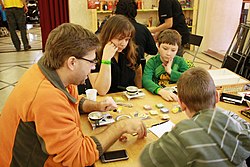A la carte (game)
| à la carte A la carte |
|
|---|---|

|
|
| Game data | |
| author | Karl-Heinz Schmiel |
| graphic |
Michael Präpasser (1989), Christof Tisch (2009), Jochen Eeuwyk (2009) |
| publishing company |
Mosquito Games , Heidelberger Spieleverlag u. a. |
| Publishing year | 1989, 2009 |
| Art | Board game |
| Teammates | 3 to 4 |
| Duration | 40 minutes |
| Age | from 8 years
|
| Awards | |
|
Goldener Pöppel / German Games Prize 1990: 2nd place |
|
The board game à la carte - a culinary gimmick by Karl-Heinz Schmiel was published in 1989 by his own publisher, Moskito . This game reached second place at the Golden Pöppel in 1990. In the same year, the Golden Pöppel was replaced by the German Games Prize , so that it also reached 2nd place in the German Games Prize. In 2009, in collaboration with Heidelberger Spieleverlag , Moskito published a revised new edition under the name A la carte , which was nominated for Game of the Year in 2010 .
background
The players slip into the role of a cook and are allowed to prepare a wide variety of dishes on the stove. To do this, the stove must be brought to the right temperature and the dish seasoned according to the recipe. During coffee breaks, players can also add seasoning to other people's dishes or swap stove and pan.
Gameplay
The aim of the game is to collect victory points. To do this, you have to complete as many dishes as possible or serve three dishes with distinction. A starting player is determined at the beginning of the game. Each player receives a coffee cup, chooses a dish and places it in the pan with the recipe side up. The starting player receives the three wooden spoons that show the actions taken. For each of the three actions, the player has two options: he can heat the stove or add seasoning to his dish. Once during his turn, the player can also take a coffee break.
The stove is heated up with the heating cube. If this shows the numbers 1 to 3, the stove must be raised by the corresponding number of heat levels. On one side, the player can choose whether to turn up one, two or three steps. The coffee cup on the die indicates that the player must remove a cup from the tray. A “one” surrounded by an arrow indicates that all players have to turn their stove one step hotter.
When seasoning, the player decides on one of the four spices lemon , pepper , paprika or oregano with which he would like to season his dish. At the beginning of the game there are 15 spice units and 5 salt crystals in all shakers. In one continuous movement, the player can turn the spreader over his pan and put it back. Any subsequent shaking is not permitted. The player should try to get as many spices as possible into the pan as stated on the recipe. If he succeeds and the stove has reached the correct heat setting, the dish is considered ready and can be set aside. The player receives an additional star tile.
A dish is also considered fully cooked if it contains more spices (including salt) and the heat level is reached; however, the player then does not receive a star. As soon as there are three or more units of a spice or salt in the pan, the dish is seasoned and it ends up in the bin; the spices go into the sink. The player turns his stove down to zero and starts a new recipe.
A player can take a coffee break once per turn. Various actions are shown on the cups. When adding seasoning, the player can choose a spice of his choice from another player and season the dish. You can also swap the stove with another player, get the three wooden spoons back and thus carry out three further actions, heat your own stove by up to three levels or receive a victory point. When a player puts a new dish in his pan, he must make sure that he has not yet finished cooking one of that color. If this is not possible for him, he takes any. If he cannot put any more dishes in the pan, the game ends.
The most important innovation in the 2000 edition is that every player receives a crepe . This is placed in the pan and the train ends. In the following moves the player always has to heat up the stove once and then has two attempts to turn the crepe in the pan by throwing it up. If the crepe lands next to the pan or does not turn on the other side, this is considered a failed attempt. Players who prepare crepe are not allowed to take a coffee break.
Game components of the new edition 2009
The game contains four metal pans with plastic handles, four transparent spice shakers with colored lids, 80 spices in four colors (lemon, pepper, paprika and oregano), 25 salt crystals and a wooden heating cube. The following game material can be removed from the cardboard punched sheets:
- 20 dishes in five levels of difficulty
- 4 crêpes, 13 coffee cups, 3 wooden spoons
- 1 coffee tray, 4 trays, 1 trash can
- 1 sink, 9 star chef plates
Awards
- 1990: The Golden Pöppel / German Games Prize : 2nd place
- 2010: Game of the year : nominated
- 2010: Game of Games : hit games for families
Web links
- A la carte in the Luding games database
- A la Carte in the game database BoardGameGeek (English)
- A la carte at Heidelberger Spieleverlag
- Game instructions (PDF file; 1.28 MB) from Heidelberger Spieleverlag